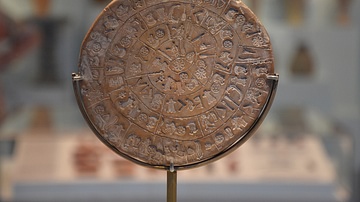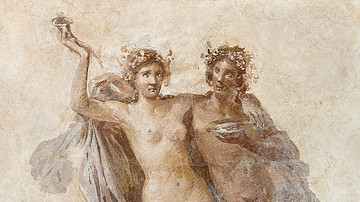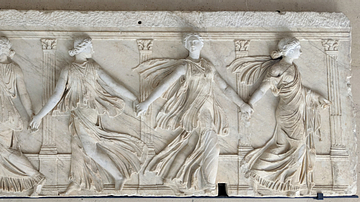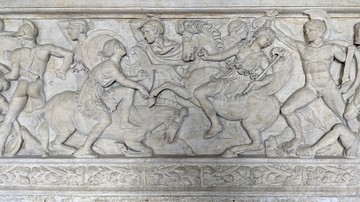Search Images
Browse Content (p. 914)

Image
Hagia Triada Sarcophagus
The Hagia Triada sarcophagus is a Late Bronze Age (1400 BCE) 137 cm-long limestone sarcophagus covered in plaster and painted in fresco and combining features of Minoan and Mycenaean style. The painted frieze shows all the stages of the sacred...

Image
Phaistos Disk
The side A of the Phaistos disk, New-Palace period (1600-1450 BCE), Heraklion Archaeological Museum, Crete.
![Throne Dais of Shalmaneser III [South Face, West End]](https://www.worldhistory.org/img/c/p/360x202/10529.jpg?v=1618801205)
Image
Throne Dais of Shalmaneser III [South Face, West End]
This scene is part of a long tributary one where the king receives Chaldean tribute from Musallim-Marduk, son of Ukani. Here, the Assyrian king, Shalmaneser III (r. 858 - 824 BCE), stands and his left hand rests on the tip of his bow while...
![Throne Dais of Shalmaneser III [South Face, East End]](https://www.worldhistory.org/img/c/p/360x202/10530.jpg?v=1599153303)
Image
Throne Dais of Shalmaneser III [South Face, East End]
This scene is part of a long tributary one where the Shalmaneser III (r. 858 - 824 BCE) receives Chaldean tribute from Musallim-Marduk, son of Ukani. The procession is headed by a bearded male figure (probably the prince). Before him...
![Throne Dais of Shalmaneser III [North Face, West End]](https://www.worldhistory.org/img/c/p/360x202/10525.jpg?v=1618801205)
Image
Throne Dais of Shalmaneser III [North Face, West End]
This scene is part of a long tributary one where Shalmaneser III (r. 858 - 824 BCE) receives tribute from Qalparunda (c. mid 9th Century BCE) of the Land of Unqi (a Luwian Syri-Hittite state, also known as Pattin). The tribute is composed...

Image
Fresco of Dionysos and Ariadne, Getty Villa
Fresco Panel Depicting Dionysos and Ariadne, between 1 and 79 CE. Nude but for the drapery swirling around them, Bacchus and his consort Ariadne walk with arms entwined against a plain white background, as if floating. Ariadne lifts a...
![Throne Dais of Shalmaneser III [South-West Re-entrant, W. Face]](https://www.worldhistory.org/img/c/p/360x202/10533.jpg?v=1618584310)
Image
Throne Dais of Shalmaneser III [South-West Re-entrant, W. Face]
This scene is part of a long tributary one where the Shalmaneser III (r. 858-824 BCE) receives Chaldean tribute from Musallim-Marduk, son of Ukani. This is the end of the procession. The first pair of men carry shallow vessels with high...
![Throne Dais of Shalmaneser III [South-West Re-entrant, S. Face]](https://www.worldhistory.org/img/c/p/360x202/10532.jpg?v=1618584310)
Image
Throne Dais of Shalmaneser III [South-West Re-entrant, S. Face]
This scene is part of a long tributary one where the Shalmaneser III (r. 858-824 BCE) receives Chaldean tribute from Musallim-Marduk, son of Ukani. On this panel, there are seven figures. The leading figure of the procession carries no...

Image
Borghese Dancers
Marble relief depicting the Hours, the goddesses of time in Greek Mythology, accompanied by the Graces. The work is typical of Neo-Attic workshops which produced Greek-style sculptures for Roman clients. The relief is named after the Villa...

Image
Greeks Battling Amazons
Greek soldiers fighting Amazons during the Trojan War. On the far right, Odysseus is shown (with a beard). Relief from the side of a sarcophagus, c. 180 CE, discovered in Thessaloniki, Greece. Louvre Museum, Paris, France (LP 2584, No...